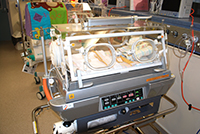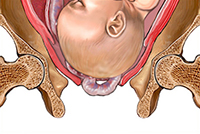Complications and unexpected outcomes in labour
Experience tells us that we cannot reliably predict or guarantee a desired outcome for any labour. Sometimes things do not go to plan or as we might expect. As in life, complications and unexpected outcomes can arise during labour. It is often difficult to think about these possibilities, but all of us have known or heard of someone who has experienced such things, and by allowing ourselves to reflect on these things, it may help to prepare us if and when we are faced with it ourselves. What your midwife and obstetrician can do to assist you during these times is to closely monitor and support you and your baby throughout the labouring process and to be ready to respond promptly and appropriately to your needs with empathy and high quality care. In this section we will cover a range of possible complications that might occur during labour.
When labour starts before full-term (Preterm labour, preterm premature rupture of the membranes)
The words preterm and premature refer to events occurring before 37 weeks gestation. If you suspect your membranes have ruptured prematurely or you experience signs or symptoms of preterm labour such as tightenings or backache, or bloody vaginal loss such as a ‘show’, please contact your obstetrician and hospital.

The baby lies within the protective amniotic sac which is made up of two membranes and the amniotic fluid (waters). Once the membranes have prematurely ruptured, continuing with the pregnancy reduces the risk of the baby having problems by being born prematurely but also increases the risk of infection getting into the uterus. If your membranes rupture prematurely your obstetrician will discuss with you the benefits and risks of both early birth or continuing with the pregnancy in your situation, but birth will usually occur somewhere between 34 and 37 weeks. Babies born before 37 weeks may have problems associated with their breathing, temperature regulation, problems with feeding and they are more susceptible to infection. Unfortunately, babies born before 23-24 weeks gestation are unlikely to survive, or if they do, can go on to have serious ongoing health problems.
Preterm premature rupture of the membranes and preterm labour are best managed in a hospital setting where you and your baby can be closely monitored and cared for appropriately. The management plan will depend on the gestation of the pregnancy and your individual circumstances, following an informed discussion with your obstetrician. Your care, how long you remain in hospital, and whether or not you go into labour and birth your baby, including the method of birth, will be determined by a range of factors including, how many weeks pregnant you are, you and your baby’s wellbeing, and any other risk factors and possible causes.
In addition to a general examination of you and your baby’s wellbeing on admission to hospital, options for the management of preterm premature rupture of the membranes and preterm labour are:
- A speculum examination to determine and/or confirm rupture of the membranes, dilation of the cervix, to take some swabs for examination of possible infection, and to remove a cervical suture (if a stitch has been placed in the neck of the womb earlier as a preterm labour prevention measure)
- CTG monitoring to check on baby’s wellbeing and presence of contractions
- Maternal blood and urine tests to determine the presence of any risk factors such as infection
- An ultrasound scan to assess the amount of amniotic fluid, pregnancy dating and baby’s wellbeing
- Maternal antibiotics to combat any infection including Group B Streptococcus
- Women with preterm premature ruptured membranes at less than 34 weeks gestation, who are at risk of preterm labour and birth, and who don’t have any infection present may be offered a course of corticosteroid medication to help mature the baby’s lungs to reduce the risk of neonatal respiratory distress syndrome and other neonatal complications. A common medication used is called Betamethasone and the injection is given to the mother into a muscle in her arm or leg in two doses given 24 hours apart
- If preterm labour ensues, there is no evidence of infection and a course of corticosteroids has not be given yet, the obstetrician may want to delay birth to allow time for the baby’s lungs to mature or in cases where the mother and baby will need to be transferred to a more appropriate facility. Labour contractions can be slowed or stopped altogether with medications called tocolytics drugs. A common drug used is called Nifedipine and it is administered orally
- The decision about when to allow labour and the mode of birth are discussed during an informed consent discussion between the mother, birth partner and their obstetrician

Depending on the booking hospital and how premature the baby is when it is born, the mother and/or baby might need to be transferred to a larger hospital with more comprehensive Neonatal Intensive Care facilities. A Paediatrician and Neonatal or Special Care Nursery nurses will be consulted and involved in the birth and subsequent ongoing care of premature babies. In general, many of our facilities have Special Care Nurseries (SCNs) where premature babies from about 32-33 weeks onwards can be cared for.
Back to Top
Fetal compromise - When baby shows signs of not coping with the labour
As previously mentioned, labour can be a challenging time for both mother and baby. Sometimes the baby may show signs of not coping with the labour. Fetal compromise is a term used to describe the situation where the baby may be experiencing a lack of oxygen during labour. The baby’s oxygen supply is dependent upon many factors associated with the mother’s health before and during pregnancy and labour, how well the placenta and cord is functioning, the course and nature of the labour and the baby’s gestation and general health.
Signs that the baby might not be coping with the labour include:
- The baby’s heart rate is outside the normal range of 110-160 beats per minute or the heart rate pattern is abnormal in appearance
- Decreased or increased fetal movements
- Passage of meconium (baby’s bowel motion) prior to birth (this causes the amniotic fluid to appear greenish or yellow/brown in colour)
- Abnormal fetal blood sampling test values (lower pH value and higher lactate value)
Blood flow and oxygen to the baby through the placenta is normally momentarily reduced during labour contractions. This is a normal physiological part of labour to prepare the baby for birth, and babies can usually cope with this, but sometimes other factors may be involved that can reduce the baby’s coping ability. These factors may include: cardiac (heart) or respiratory (lung) disease in the mother, pre-eclampsia, haemorrhage, hypertonic (overly strong or long lasting contractions with little rest in between) uterine contractions, very rapid or prolonged labour, pressure on or prolapse of the baby’s umbilical cord, post maturity, prematurity or other conditions affecting the baby and/or mother. However, the cause of fetal compromise is not always apparent and it can be a once-off event or it may occur intermittently throughout the labour.
Your midwife will monitor you and your baby’s wellbeing throughout labour by regularly recording your vital signs, your baby’s heart rate, your contractions and progress in labour. If your midwife observes signs of fetal compromise during your labour, depending on the situation, she/he:
- Will inform and explain to you and your birth partner the situation and what options there are
- Will request you to turn onto your left side (usually, but it could be the right). This increases the flow of blood and oxygen through the placenta to the baby
- May turn off any oxytocin IV infusion in progress or remove prostaglandin vaginal tablets to slow or stop contractions and thereby increase blood flow and oxygen to the baby
- May give you a medication that causes the uterus to relax (called a tocolytic drug) and thereby increase blood flow and oxygen to the baby
- May give you oxygen and/or extra IV fluids if you have signs of dehydration, bleeding or shock to increase your oxygen carrying capacity
- May perform a vaginal examination to check for presence of the baby’s cord, assess the presenting part, position, how far the baby has descended into the birth canal and dilation of the cervix
- May commence CTG monitoring or check that the CTG transducers or fetal scalp electrode are correctly applied and not malfunctioning. This may involve checking your pulse at the same time because the transducer can sometimes pick up the mother’s heart rate too
- Will notify your obstetrician and other members of the Maternity Team of the situation
Your obstetrician will assess you and your baby and discuss with you the most appropriate course of action based upon your individual circumstances, the phase and progress of your labour and the possible cause and severity of fetal compromise. Possible options include:
- Waiting to see how the baby responds to the abovementioned steps. Most times these actions are sufficient and you can continue to labour under close observation. The exact cause of fetal compromise is not always apparent and it may be a one-off event
- Performing fetal blood sampling to better assess the baby’s oxygenation levels
- Deciding that the baby needs to be born immediately if the signs of fetal compromise are severe or have continued despite measures to relieve it. Depending on your own wellbeing and the cause and severity of the fetal compromise, if you are almost in second stage, an instrumental birth may be achieved, but otherwise an emergency caesarean birth may be the safest option for you and your baby
Back to Top
Bleeding during labour
Very rarely, bleeding can occur suddenly during labour. This is called intrapartum haemorrhage. It may be caused by a variety of conditions such as premature separation of the placenta from the uterine wall (placental abruption); where the placenta lies near to or over the cervix (placenta praevia); where umbilical blood vessels, normally supported in the cord, cross the membranes (vasa praevia); and tearing of the uterine wall (uterine rupture) in labour.
Heavy bleeding during labour is most likely to be due to premature separation of the placenta which may also cause abdominal pain and/or result in signs of fetal compromise. Placenta praevia, vasa praevia and placental abruption are usually detected by ultrasound scan during pregnancy, and are usually conditions for which elective caesarean birth is recommended, but they can occasionally reveal themselves once labour commences. Mild bleeding may come from the cervix, or may just be a heavy form of 'show' and this is usually nothing to be concerned about.
Your midwife will monitor you and your baby during labour and this includes checking your vaginal loss. If you experience any bleeding vaginally or extreme or one-sided pain in the abdomen during labour please inform your midwife immediately. A number of scenarios could play out, depending on the cause, location and amount of bleeding.
If the bleeding is only mild, the labour may continue to be closely monitored, depending on the cause, your vital signs and the baby's heart rate, and how the labour progresses. Sometimes it might be possible to go on to have a normal vaginal birth. If heavy bleeding does occur during labour, then oxygen and intravenous fluids may be given and your vital signs (respirations, pulse and blood pressure) and fetal heart rate will be closely monitored. Your obstetrician will discuss the option of caesarean birth with you if you experience heavy bleeding during labour and there are any risks to you or your baby.
The type of anaesthesia used for the birth will be dependent upon the urgency of the situation and a general anaesthetic may sometimes be more appropriate even if you already have an epidural. Sometimes if the bleeding is excessive, blood replacement products may be recommended. If bleeding is severe, you might need ongoing care in an Intensive Care environment. Rarely, if severe bleeding is caused by uterine rupture, an emergency caesarean birth and hysterectomy may be necessary. Depending on the gestation, wellbeing of the baby and amount of blood loss, the baby may need initial or ongoing care in a Special Care Nursery or Neonatal Intensive Care Unit.
Back to Top
When the baby’s cord sits in front of the baby (Cord presentation and prolapse)
Cord presentation is a situation where a loop of cord slips down in front of the baby but the membranes have not yet ruptured. For example, the cord may sit in front of the baby’s head and rest between the head and the lower part of the uterus near the cervix. Cord prolapse occurs when the membranes rupture and a loop of cord slips down alongside or in front of the baby (it could be the head, or bottom, if the baby is lying by the breech). Sometimes the cord can be felt sitting in the vagina on vaginal examination or it can even be visible outside the vagina if it prolapses completely when the membranes rupture.
When cord presentation or cord prolapse occur antenatally or in the first stage of labour, the safest way to deliver the baby is usually by emergency caesarean birth. Until this can be achieved, and whilst the rest of the Maternity Team is preparing for the caesarean birth, your obstetrician or midwife will likely undertake these specific actions to relieve any cord compression to improve oxygen flow to the baby:
- Explain the situation to you and your birth partner so you understand and can assist in these measures
- Request and assist you to lie on your left side, or with a wedge placed under your hip or to adopt a hands and knees position. These actions serve to elevate the baby back up into the uterus and to take the pressure off the cord
- If the cord has prolapsed, they will perform a vaginal examination to push the baby’s head or other presenting part off the cord and/or place a urinary catheter in your bladder and fill your bladder to act as a cushion in holding the baby’s head or other presenting part up until the caesarean can be achieved
- Insert an IV if not already in place and they may give you oxygen to prepare you for the caesarean birth
- You might be advised that a general anaesthetic is the quickest and most appropriate method of pain relief and anaesthesia for the emergency caesarean birth even if you already have an epidural in place
A Paediatrician and registered nurses or midwifery staff will be present at the birth to support the baby and provide resuscitative measures. Thankfully, in most cases the baby will be born healthy and well. Sometimes a baby will experience a lack of oxygen leading to brain damage, depending on individual circumstances, the cause, the length of time cord compression occurs and gestation and wellbeing of the baby. The Neonatal Team will be able to provide more information about the ongoing care of babies experiencing these issues. Sadly, in a small minority of cases, the baby may die.
Cord prolapse is often unpredictable and it does not necessarily mean that it will happen again in a subsequent pregnancy. It may be possible for the mother to go on and have another pregnancy and normal labour and birth. You can find more information about cord presentation and cord prolapse in the Resources.
Back to Top
What if labour progress slows down?
Just as each pregnancy differs among women, so too can the progress of labour, including its intensity and duration. Recall that we previously described the active phase of labour (that is when the cervix has already dilated to 3-4 cms) as being characterised by contractions that are much stronger and painful, that are closer together (every 2-3 minutes) and lasting longer (50-60 seconds). In the presence of such good contractions the cervix is generally expected to dilate 1cm or more per hour, and the active phase of most labours will usually not last longer than 12-14 hours. Progress in labour is generally determined by a number of factors. Some of these include:
- The strength, duration and frequency of the contractions
- The progressive dilation of the cervix
- The baby’s lie and position, and rotation and descent of the baby’s presenting part downwards through the mother’s pelvis
- The size and number of babies this pregnancy
- The size of the mother’s pelvis
To take account of the wide variation in what is considered normal progress in labour among women; cervical dilation that is less than 2 cm in a 4 hour period can be defined as a delay in the active phase of labour, but all of the abovementioned factors must be taken into account when assessing progress.
A delay in the active phase of labour may indicate that something has gone wrong with the normal progress of labour. A prolonged or difficult labour resulting from the delay can lead to more stress and fatigue for both mother and baby, and the risk of other complications such as infection, fetal compromise, postpartum haemorrhage, uterine rupture and instrumental or emergency caesarean birth. When delay occurs, the Maternity Team will wish to assess the possible causes and propose ways to remedy the situation and avoid further complications. Some common conditions that can slow or impede the progress of labour include:
- Conditions in the mother that weaken the quality of the contractions such as dehydration or exhaustion, excessive pain, stress and lack of sleep. Sometimes pain relief medications and anaesthetics can also affect the quality of the contractions.
- Conditions that can result in a relative or absolute mismatch between the size of the mother’s pelvis and the baby that may prevent the baby rotating and moving down through the pelvis. These can include a small pelvis in the mother, a large baby, the way a baby presents or the position it lies in the uterus, abnormalities of the uterus such as fibroids, a full bladder in labour and immobility in labour and adopting a prone lying position.
A delay in progress, depending on the cause, can be potentially reversible or irreversible, but there are some things you can do to enhance your labour in addition to the assistance provided by your Maternity Team.
It is very important to know the difference between the early phase of labour and the active phase and to be able to pace yourself so you won’t be dehydrated, stressed or exhausted before active labour actually starts. First stage - labour gives some guidance on how to avoid these situations contributing to slowing or delaying labour progress. Once labour is established, active birthing techniques such as walking around, choosing a variety of different positions and movements in labour and birth, and using a variety of props and tools such as a bean bag, chair or birthing ball, can also enhance the progress of labour.
Back to Top
What your Maternity Team can help you with
In addition to regularly monitoring you and your baby’s wellbeing in labour by observing your vital signs and the baby’s heart rate, your midwife will also observe and assess your progress in labour by palpating (feeling) your abdomen to assess the strength, duration and frequency of your contractions, and the baby’s lie, position, rotation and descent into your pelvis. She/he will also assess your cervical dilation by vaginal examination.
If any of these observations indicate there is a delay in progress, there are some things that can be done to improve the situation where this is potentially reversible, and labour can usually continue. The decisions on how to manage slow progress in labour is a collaborative effort between you, your birth partner/support person and the Maternity Team. Sometimes, where the situation is not reversible or the wellbeing of the mother and/or baby is compromised in the first stage of labour, an emergency caesarean birth is usually recommended. Where the situation is potentially reversible, depending on the cause, these are some things than can be done to improve it.

Too much pain can increase fear and anxiety and in turn, slow labour progress, yet, paradoxically, some pain relief medications or anaesthesia, such as an epidural, can also slow progress and prolong labour. So it will be important to get the timing and balance of pain relief right. Stress hormones produced in response to pain and fear can cause the uterus to contract in an uncoordinated manner that reduces the effectiveness of the contractions and in turn can cause fetal compromise. Women who labour with epidural pain relief may experience slower progress and need augmentation (see below) during the first stage. It is also usual to delay active pushing for an extra hour in second stage to allow for this slowing effect. In all cases however, it is expected that birth will have occurred within 4 hours of full dilation.

Dehydration and lack of nutrients during labour can contribute to slow progress by affecting the supply of nutrients to the uterus and therefore how well it contracts. By giving IV fluids, this imbalance can be corrected and normal progress resumes. It will be important to remember to regularly empty your bladder to avoid a full bladder getting in the way and again slowing progress.

The membranes in front of the baby’s presenting part (usually the head) are called the forewaters. They form a cushion between the baby’s head and the cervix. Rupturing the membranes causes a two-fold effect: a release of prostaglandins that increases contractions, and the release of amniotic fluid allows the baby’s head to descend and be better applied to the cervix, causing it to dilate. ARM is ideally performed in the active phase of labour.

Slow progress in labour may also be sped up using an IV infusion of Syntocinon. This is called augmentation of labour. Contractions augmented in this way can be more painful and so effective pain relief is required as well as closer monitoring of the baby.
If these options don’t improve progress or labour becomes obstructed, and you and/or your baby’s wellbeing is compromised, then your Maternity Team may recommend emergency caesarean birth as the safest and best way to manage the situation.












